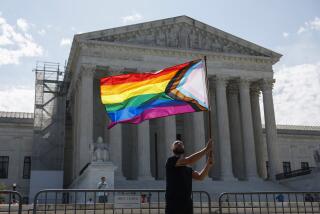The Ties That Still Bind : DOMESTIC REVOLUTIONS A Social History of American Family Life<i> by Steven Mintz and Susan Kellogg (The Free Press: $22.50; 307 pp.) </i>
- Share via
Nobody dislikes families--except perhaps adolescents for a brief time. Gov. Mario Cuomo has used the term to describe his conception of the nation. Charles Manson called his group by the same name. Marxian Communism’s ideal, “from each according to his abilities, to each according to his needs” is but our unstated meaning of family explicated, and defenses of “family values” appear in every politician’s litany of promises. But what is the family, which so many of us seem to cherish?
Steven Mintz and Susan Kellogg--themselves progenitors of a family as well as students of the institution and professors at the University of Houston--make clear that a definition is not easy to come by. The reason is that the family is an abstraction that historically has contained a variety of meanings. In their book, which is based on wide reading in letters, diaries and other contemporary documents, Mintz and Kellogg see several types of families in the United States in the course of the last three centuries.
The first, in the Colonial period, was a modification of the European institution brought by the first settlers. It was the basic unit of society as the family has never been since: Outside a family, an individual had no existence. In Puritan Massachusetts, for example, single men arriving in a town were required to marry, that is, to be part of a family, or leave town. The husband was the head of the family, but all members participated in its support--survival demanded no less. New England families, the authors show, differed from those farther south, and both varied greatly from families of Amerindians. Variety, in short, was there from the beginning. So was change.
The heart of this informative book is the change in the families of whites (working class, immigrants, and middle class) and blacks (slave and free) since the Colonial years. The authors identify four deep changes in family structure and ideology from the days of the Revolution to the present: the democratic family, the companionate family, the family of the 1950s, and the family of the ‘80s.
Neither the differences among these families nor the causes for the changes can be more than suggested here, though the authors present a clear and persuasive exposition of both. Moreover, they engagingly illustrate each of the changes with a story of an actual historical or contemporary family. Suffice to say that the underlying force for change, which gathered momentum in the course of three centuries, was the growing emphasis upon the happiness of individual family members.
An early manifestation of that force can be seen in the 19th-Century democratic family, in which patriarchal authority was steadily reduced, to be followed in the early 20th Century by the companionate family, in which the husband and wife are equal companions and their primary obligation is to their children. One structural consequence of this same trend was fewer children per family--family size fell 50% between 1800 and 1900--constituting a gain for wives, and for children, who now received greater individual attention.
The companionate family suffered severe testing under blows from, first, the Great Depression of the 1930s and, then, World War II. But rather than changing the family, the double buffeting highlighted the family’s resilience, as evidenced by the vigorous revival in the 1950s of the companionate family. Indeed, as Mintz and Kellogg shrewdly suggest, depression and war had raised social and economic impediments to the full realization of the companionate family. The removal of those obstacles after 1945 thus lay at the root of the well-known upsurge in family formation in the 1950s, what the authors call “the golden age” of families. The improved incomes and greater social tranquility of the era encouraged Americans to opt for family creation to an unprecedented degree.
The book provides several explanations for the end of the golden age and the arrival of the so-called “crisis of the 1980s,” but none of the forces pointed to seems as novel as the authors imply. Divorce is an old and even peculiarly American threat to the family, and even fundamental changes in married women’s role in the economy go back to World War II. What was novel was that the changes in the 1960s and 1970s took place within the context of a revived feminist outlook that penetrated the layers of society more deeply than ever before. That transformation in the nation’s conception of women’s place was but the latest working out within the family of historical American individualism. The result, as the authors rightly conclude, is that Americans today, paradoxically enough, “may attach far greater psychological and ideological significance to a happy family” than our ancestors ever did, yet today “our work lives, our emphases on personal fulfillment and our political behavior all conflict with strong, stable family bonds.”
Mintz as a historian and Kellogg as an anthropologist offer no novel panaceas to resolve the paradox. They are reassured, however, by the successful adjustments made by American families over the last four centuries to changes in the social order. Families are indeed resilient and adaptive even as their shape and purpose alter over time. Today most families contain working wives as well as working husbands, yet almost one-quarter of families have no husbands present at all. At one time, a family was a social organism in which individuals were embedded; today a family is more likely to be consensually united individuals. As such, families may well need shoring up by society if we want them to continue to serve as “our primary unit of nurture and emotional sustenance,” to quote Mintz’s and Kellogg’s 1987 definition of an institution that has indeed come a long way from its Colonial beginnings.
More to Read
Sign up for our Book Club newsletter
Get the latest news, events and more from the Los Angeles Times Book Club, and help us get L.A. reading and talking.
You may occasionally receive promotional content from the Los Angeles Times.










